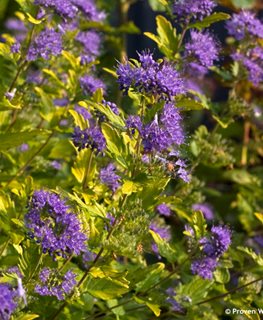Grow Beautiful Bluebeard Plants in Your Garden
Get tips for planting, caring for, and using these showy fall-blooming shrubs. Published 10/6/2022Brilliant true-blue flowers are a rarity in any season, particularly in the fall when the garden is awash in toasty shades of gold and burnt orange. That’s the delightful surprise of Caryopteris (bluebeard), a late-blooming shrub covered with fragrant clusters of airy blue flowers in late summer until the first chill of frost.
Compact in size, this drought-tolerant bloomer thrives in almost any sunny location and is especially well-suited for space-challenged gardens, shrub borders, mass plantings, and containers. Even when bluebeard is not in bloom, the colorful, aromatic foliage adds ornamental interest and fragrance starting in early spring and lasting throughout the entire season.
On this page: Basics | Planting | Care | Varieties | Landscaping Ideas
BASICS
Botanical name:
Caryopteris spp.
Common names:
Bluebeard, blue mist spirea—although not related to spring- and summer-blooming Spirea
Zones:
5-9
Plant type:
A deciduous shrub, but often treated as a perennial in colder climates because the above-ground growth will die back in harsh winters.
Exposure:
Full sun
Size:
2 to 4 feet tall and wide
Bloom time:
Usually late summer through early fall, with some varieties blooming until mid-fall.
Foliage:
Linear, finely toothed leaves may be gray-green, silver, gold, bright yellow, or variegated, depending on the variety. Rub or crush the leaves with your hands to enjoy their pleasant, eucalyptus-like scent.
Flowers:
Arranged along the length of the stems in feathery whorls, Caryopteris flowers range in color from powder blue to deep violet-blue, although pink-flowered cultivars are also available. The base petals are elongated like tiny beards, inspiring the plant’s common name.
Special attributes:
- Attracts bees, butterflies, and hummingbirds
- Drought and heat tolerant
- Low maintenance
- Fragrant flowers and foliage
- Rabbit and deer resistant
HOW TO PLANT BLUEBEARD
When to plant:
The cooler months of spring or fall are the best times to plant bluebeard to prevent transplant shock from extreme summer heat. Avoid planting too late in the season, especially in colder regions. Ideally, you should get your plant in the ground at least a month before a heavy freeze to allow time for the roots to become established.
Where to plant:
Grows best in a sunny spot that receives at least 6 hours of direct sun daily. Will also tolerate light shade, but plants won't bloom as well and may become spindly. Avoid planting in a site where the soil remains wet in winter and early spring.
How to plant:
When planting from nursery starts, dig a hole about twice the width and just as deep as the size of the container. Remove the plant, gently teasing apart the roots, and place in the hole with the crown level with the soil surface. Backfill with the native soil, then water thoroughly.
Spacing:
Space bluebeard shrubs at least 2 feet apart, depending on plant size at maturity. For shrub borders and mass plantings, closer spacings will result in a fuller look and greater impact.
BLUEBEARD CARE
Watering:
Caryopteris is a great shrub for waterwise gardens because it only needs supplemental watering during prolonged dry spells. The exception is young plants, which should be watered regularly until they become established.
Amendments and fertilizer:
Bluebeard shrubs will flourish with only light mulching and some organic matter mixed into the soil at planting time. Avoid overfertilizing, which will stimulate foliage growth at the expense of flower production. Amending the soil with compost or other organic matter will also help to improve drainage.
Pruning and deadheading:
Similar to other flowering shrubs that produce flowers on new growth, Caryopteris can be pruned hard in spring by cutting the woody stems down to just above new emerging shoots. This will also encourage sturdier, denser growth.
There is no need to deadhead bluebeard for continual bloom, and the seedpods that remain after the flowers fade can provide ornamental interest or be used in dried flower arrangements. If you want to avoid possible seed spread, remove the spent flowers before they go to seed.
Soil:
Thrives in ordinary, well-drained soil. Will not tolerate heavy clay soils or wet feet in winter.
Propagation:
Although bluebeard may self-sow, you can also propagate it by softwood stem cuttings taken in late spring.
Pests and diseases:
Caryopteris has no serious pest or disease problems, but crown rot can be an issue in poorly drained soils.
BLUEBEARD VARIETIES
LANDSCAPING IDEAS
Because of its compact size, Caryopteris has a multitude of uses in garden beds and borders. Try some of these design ideas:
- Use to create a fragrant border for perennial beds, walkways, and patios.
- Plant taller varieties in a tight row to create a low, solid hedge.
- Include in a butterfly garden to attract late-season pollinators, such as swallowtails, monarchs, and viceroy butterflies.
- Use smaller varieties alone or as thriller elements in large containers.
- Plant alongside warmly colored yellow or orange late-summer bloomers to create a cooling contrast, such as black-eyed Susan, blanket flower, coneflower, coreopsis, and sunflower.
- Other great companion plants for bluebeard shrubs: butterfly bush, ornamental grasses, butterfly weed, and perennials with gray-green leaves, such as Russian sage and lavender.














